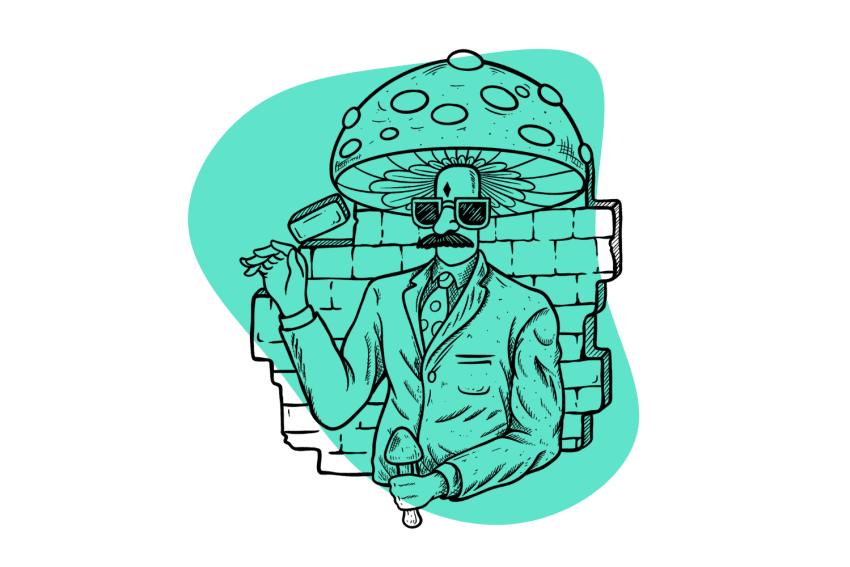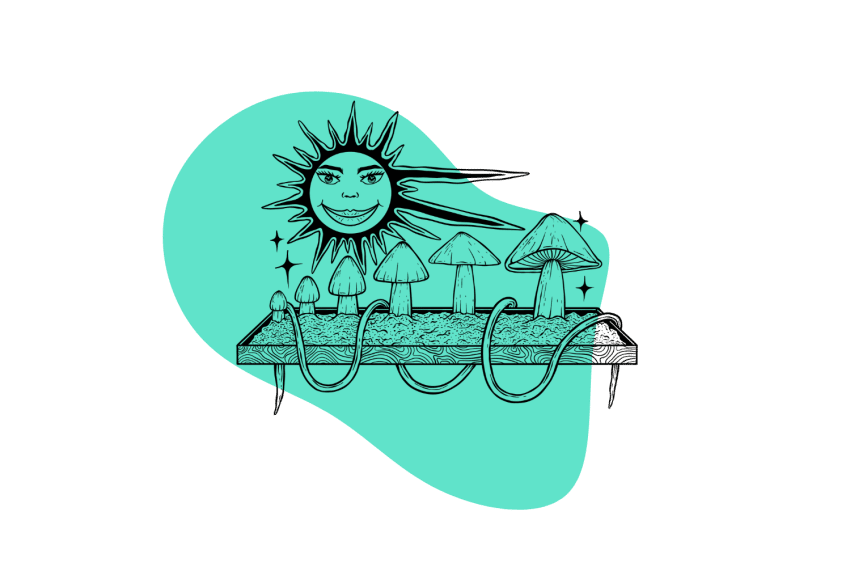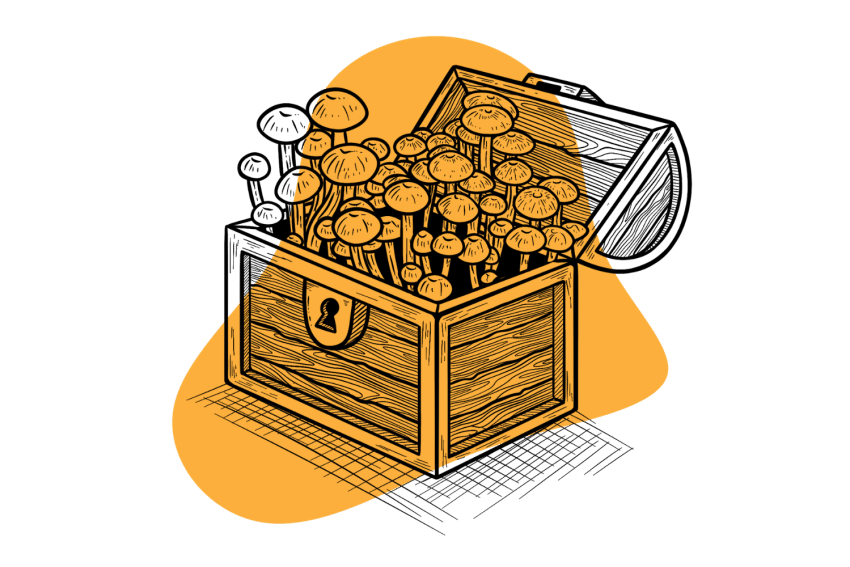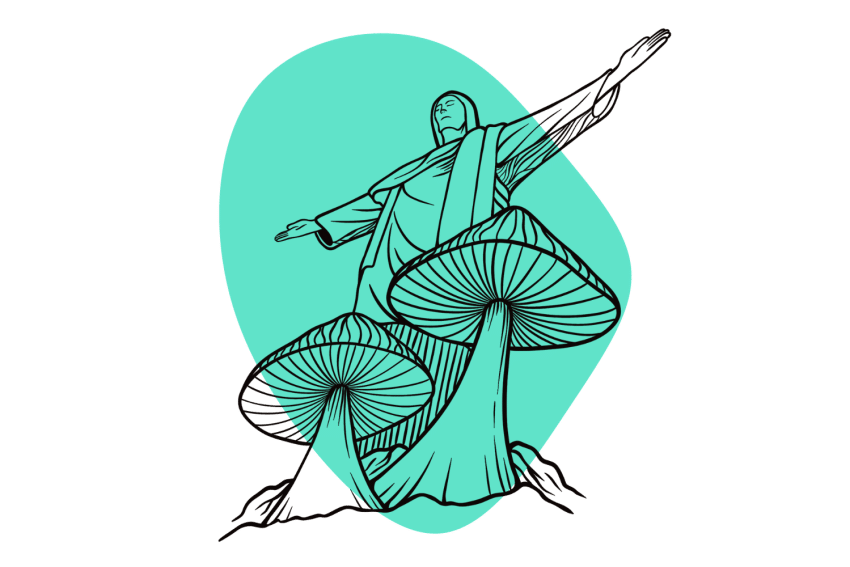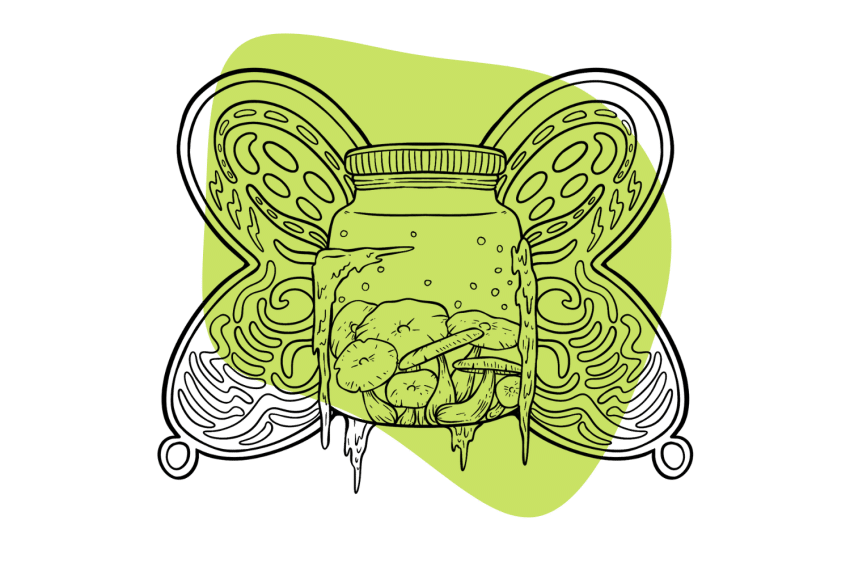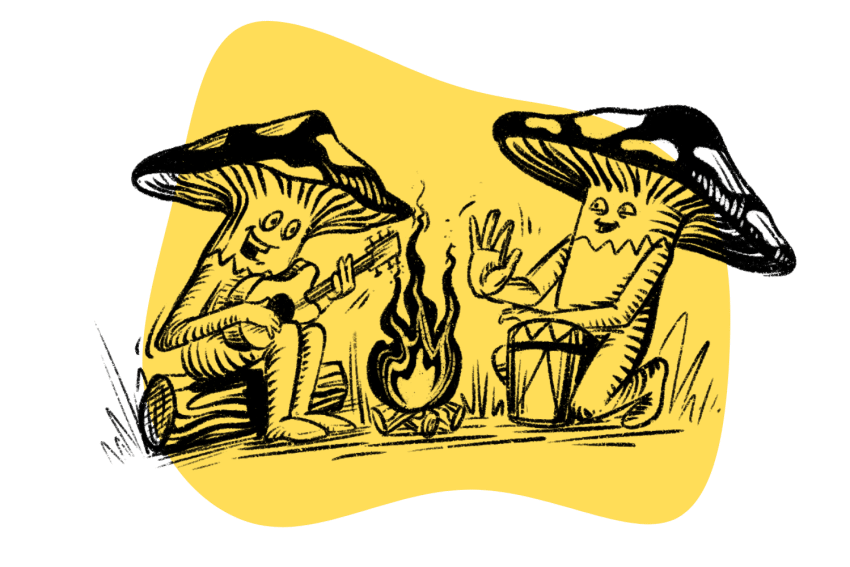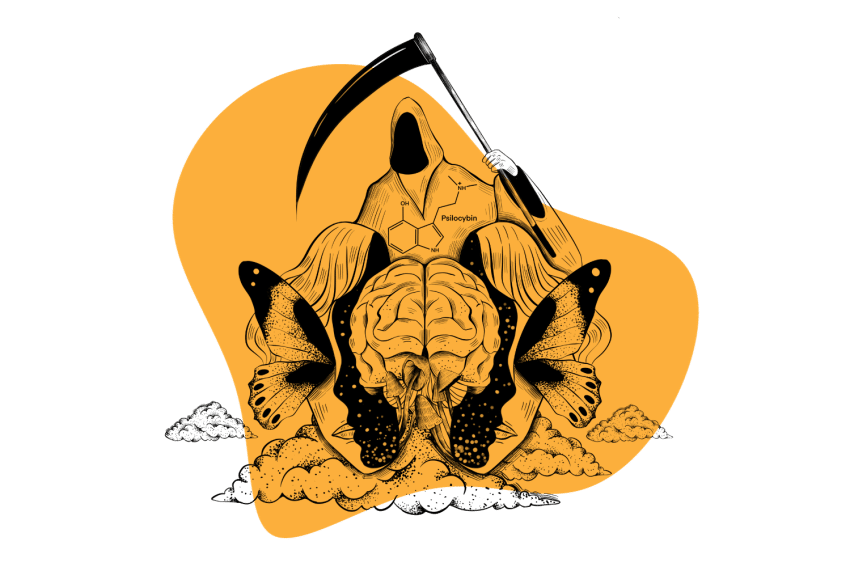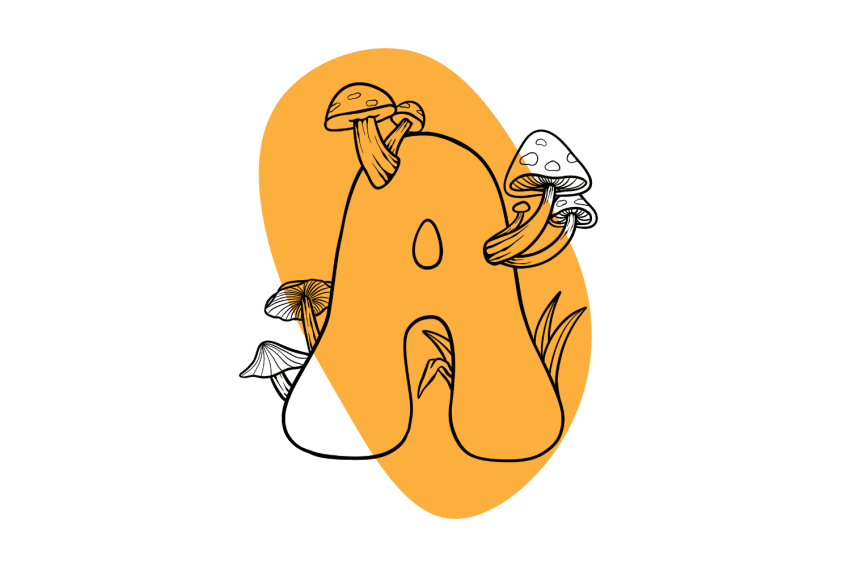Amanita Muscaria: Fly Agaric — The Psychedelic “Mario” Mushroom 🍄
Exploring this famous, but misunderstood species of psychedelic fungi.
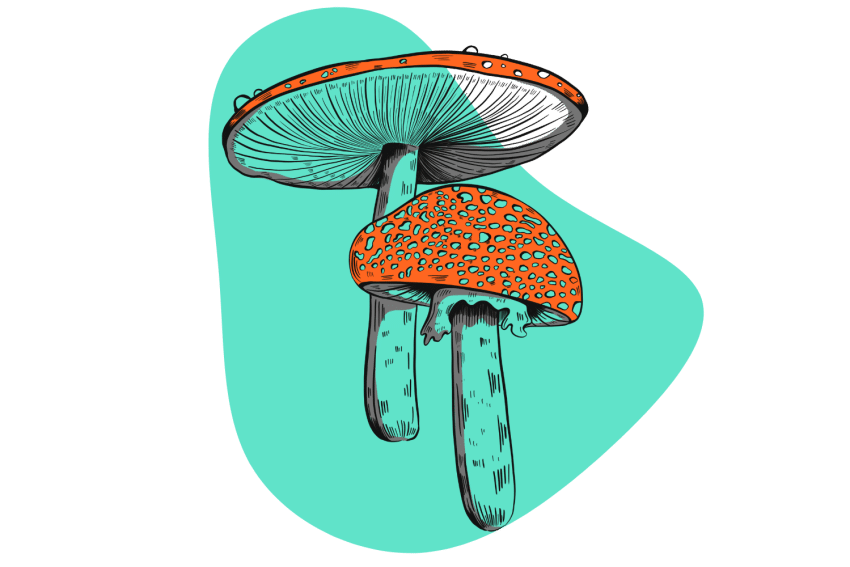
Amanita muscaria (fly agaric) is one of the most ubiquitous mushroom species on the planet. Its distinct red and white color makes it hard to miss.
But there’s more to this mushroom than meets the eye.
The fly agaric is deeply and strangely psychedelic in a way unlike any other psychoactive substance on Earth. There are also theories that early traditions surrounding this mushroom are what lead to the folklore surrounding Santa Claus and his flying reindeer.
In this guide, we’ll cover everything you need to know about this bizarre and interesting psychedelic mushroom.
We’ll cover how to prepare fly agaric, what dose to take, what risks to be aware of, explore some of the folklore and discuss mentions of this mushroom in pop culture. We also examine why it’s considered a “dream psychedelic” and how it works.
Caution: This mushroom is toxic in higher doses or if prepared incorrectly. I recommend you avoid this mushroom unless you’ve done your homework and know what you’re getting yourself into first.
Alternatively, you can order extracts from companies that make commercial Amanita products, such as Psyched Wellness.
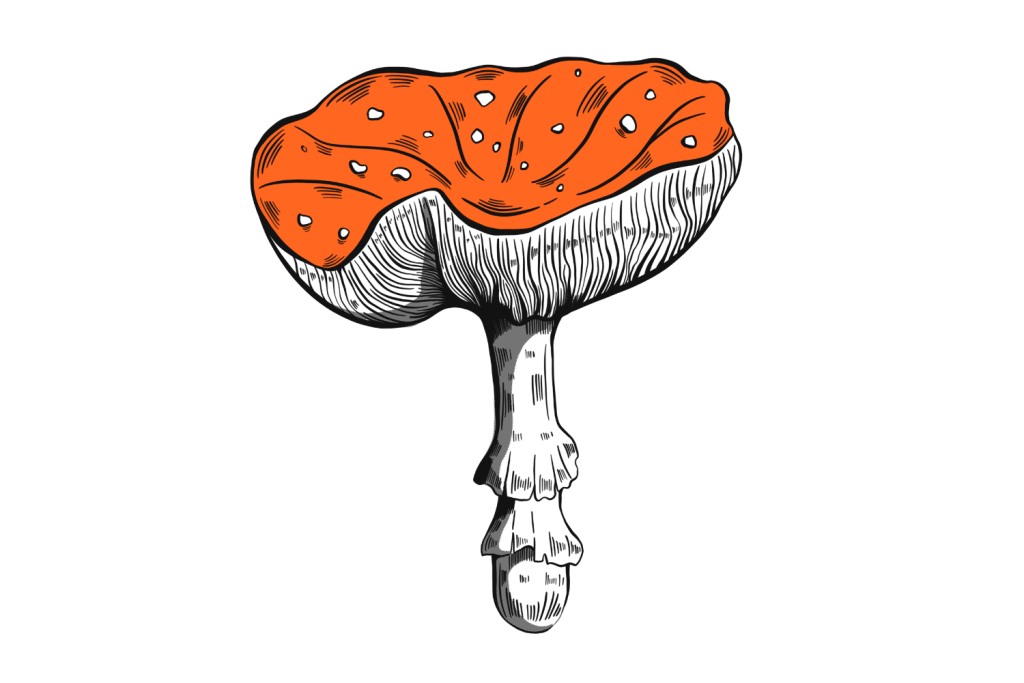
What is the Amanita Muscaria Mushroom?
Amanita muscaria (AKA the Fly Agaric) is a species of fungi that can be found in temperate forests all over the world.
This shroom is classified as a psychedelic — but it’s not exactly psychedelic — not in the conventional context at least. Users experience changes in sensory perception, but not like any other hallucinogen on Earth. Hallucinations from this mushroom are best described as lucid — objects appear distorted, and it becomes difficult to assess the true size of both the self and external objects.
It’s very difficult to achieve a serious visionary experience at all. You need to take high doses for it to be truly hallucinogenic, but these doses also bring a lot of uncomfortable, potentially dangerous side effects.
This mushroom is more of an oneirogen than a proper psychedelic.
An oneirogen is a substance that induces or enhances dreamlike states of consciousness.
Most people fall asleep a few hours after taking fly agaric, which is when the real effects of this mushroom show their true colors — injecting you into a world of bizarre dreamscapes. The dreams this species of fungi induce are so deeply strange and chaotic it’s virtually impossible to make sense of or share the experience in words once it’s over.
Because of the unpredictable nature of this psychedelic and the high risk of side effects, we don’t recommend anybody take this mushroom for its psychedelic effects.
Most people who use this mushroom “regularly” (that is, more than once) take light doses or microdoses for the sake of promoting more vivid dreams. It works very well for this — almost too well.
The dreams induced from this mushroom are hard to make sense of and are rarely considered “visionary” because of how chaotic and random they are.
Amanita Muscaria Specs & Technical Details:
| Active Ingredients | Ibotenic Acid & Muscimol |
| Level of Risk | Medium-High |
| Street Names | Fly Agaric |
| Most Common Side-Effects | Nausea, vomiting, stomach cramping, sedation |
| Duration of Effects | 6–12 Hours |
| Legality | Legal in most parts of the world |
The Dangers of Amanita Muscaria
Amanita muscaria has a bad reputation for being deadly poisonous. Most mushroom identification guides list this species as poisonous.
While it’s true that several of the compounds contained in the mushroom flesh are neurotoxic, there hasn’t been a reported death from this mushroom in over 100 years — according to the North American Mycological Association.
With that said, toxic side effects have been reported — especially among people taking particularly high doses or those with preexisting liver or kidney disease.
The Effects of Fly Agaric Are Unpredictable
The effects of this mushroom are highly variable. One person may eat it and experience a very enjoyable and insightful trip — others may end up in the hospital after enduring a nightmarish experience.
Fly agaric could be considered a deliriant — which produces a state of mind where it’s difficult to discern what’s real and what’s a dream.
These types of substances are exceptionally unpredictable. Some people freak out and face legitimate physical harm — others feel euphoric and connected with the universe.
Some will feel completely normal with only a slight twinge of “weirdness “ in their sphere of consciousness.
Fly Agaric Contains Toxic Compounds
One of the active ingredients, ibotenic acid, is a known neurotoxin. It’s also a prodrug for the main psychoactive component — muscimol. Muscimol is also toxic, but only in high doses. The LD50 of muscimol is reported to be 45 mg/kg in rats and 20mg/kg in mice (orally). This is many times higher than the standard psychoactive dose.
There’s another substance in fly agaric called muscarine. This compound is found in relatively trace amounts in fly agaric and can be further reduced by boiling or heating the fungus before eating it.
Muscarine is abundant in many other toxic mushroom species, including Inocybe erubescens and various Clitocybe species (C. dealbata and C. rivulosa).
Lastly, fly agarics are known to bioaccumulate vanadium from the soil in the form of a molecule called amavadin. Vanadium is a hard, rare earth metal found in trace amounts in the soil. Some samples of fly agaric have revealed vanadium levels up to 400 times what’s normally detected in plants and fungi [2].
It’s unclear what the health impact of high levels of organic vanadium is. Synthetically concentrated forms of vanadium are highly toxic.
Other Members of the Amanita Family Are Deadly Poisons
Despite how distinct this mushroom is, there have been cases of people misidentifying it in the wild — sometimes with lethal consequences.
Several members of this family of mushrooms share a similar appearance to the fly agaric at various stages of growth — aptly named the death cap, destroying angel, or fools’ mushroom.
Don’t attempt to wild harvest this mushroom unless you’re 100% sure which species you’re harvesting.
Deadly Species in the Amanita Genus Include:
- Amanita abrupta
- Amanita arocheae
- Amanita bisporigera
- Amanita exitialis
- Amanita magnivelaris
- Amanita ocreata
- Amanita phalloides
- Amanita proxima
- Amanita smithiana
- Amanita subjunquillea
- Amanita verna
- Amanita virosa
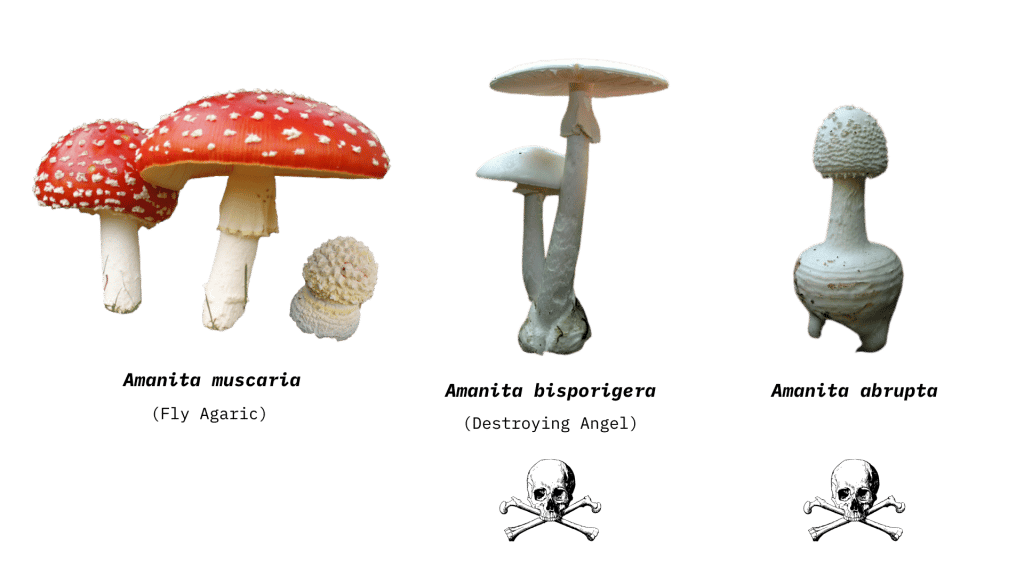
Another species, known as Amanita persicina or the “peach-colored fly agaric”, was once thought to be a unique strain of Amanita muscaria but is now considered a distinct species. It’s unclear whether this species is just as toxic or more toxic than Amanita muscaria — but it should be avoided nonetheless.
What Does Amanita Muscaria Feel Like?
The psychoactive effects of the fly agaric mushroom are unique from other psychedelics. It’s considered an oneirogen psychedelic — but could be argued as a deliriant as well. This mushroom induces dreamlike states of consciousness. This effect happens whether you’re physically asleep or not.
When you’re awake, the mushroom doesn’t produce strong hallucinations but it can alter the perception of time and can make objects appear larger or smaller than they really are.
The effects (usually) start out feeling energetic. This effect is caused by the ibotenic acid, which hasn’t been converted to the more psychedelic and sedating metabolite, muscimol.
As the effects take hold, users start to feel strange. It’s a high that’s unlike any other psychedelic. Users don’t feel like they’re tripping, but everything starts to feel indescribably “weird.”
Most people report feeling euphoric and energized in the beginning, but around the 3-hour mark, the effects become powerfully sedative as more of the ibotenic acid is converted to muscimol.
From here, the trip takes a much more lucid direction. Users will often fall in and out of sleep — each time experiencing increasingly bizarre and vivid dreams. The dreams are so strange and hazy it’s nearly impossible to describe or make sense of them.
It’s hard to find trip reports from this substance because the visions produced are hard to put into words.
Common experiences with this mushroom include:
- The sensation of flying
- Heightened sensory awareness
- Euphoria
- Lucidity & dreamlike haziness
- Feelings of being very light or very heavy
- A sensation of hyperawareness towards one or more parts of the body
- Vision in general feels especially crisp, but lights appear fuzzy
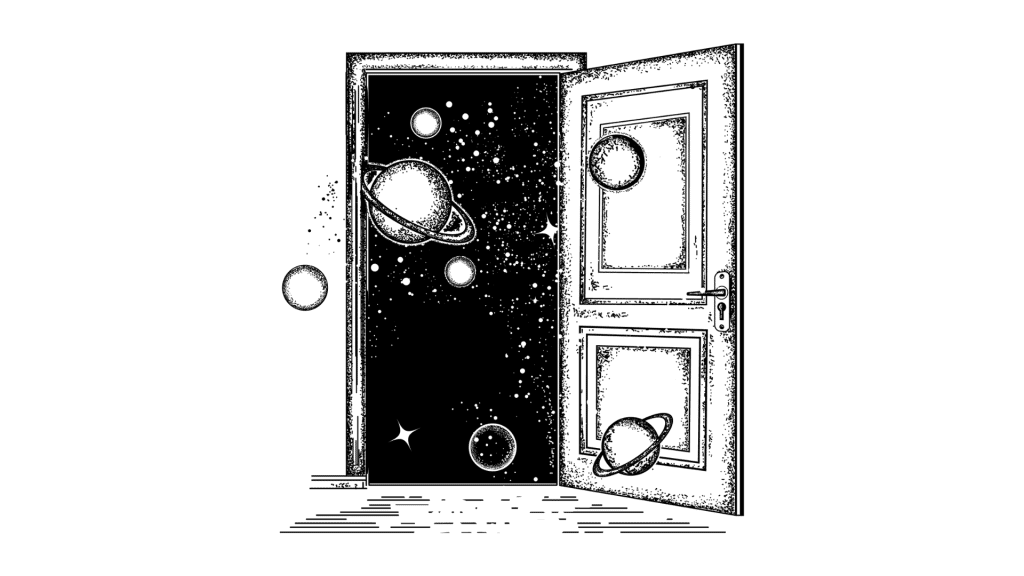
What Are The Side Effects of Amanita Muscaria?
Just like the positive effects are unpredictable, the side effects of using this mushroom are unpredictable as well.
The most common side effects are nausea, vomiting, and drowsiness — but there are many other potential side effects users have reported as well:
- Nausea & vomiting
- Sweating
- Salivation
- Low blood pressure
- Lack of muscle coordination (ataxia)
- Mood changes & irritability
- Delirium
- Increased urination
- Seizures (rare)
The effects of this mushroom are classified as cholinergic — meaning they stimulate the activity or release of acetylcholine. This neurotransmitter is the primary regulator of the parasympathetic nervous system — which controls our “rest and digest” response and runs in contrast to the sympathetic nervous system (fight or flight).
Cholinergic compounds essentially increase parasympathetic activity and suppress sympathetic activity. This causes side effects like excess salivation, reduced heart rate, low blood pressure, sweating, increased urination, and vomiting.
In high doses, cholinergics like fly agaric can lead to a condition referred to as “cholinergic crisis.”
This produces a collection of symptoms summarized by the acronym SLUDGE:
- Salivation — stimulation of the salivary glands
- Lacrimation — stimulation of the tear glands
- Urination — relaxation of the internal sphincter muscle of urethra and contraction of the detrusor muscles
- Defecation
- Gastrointestinal distress — Smooth muscle tone changes causing gastrointestinal problems, including cramping
- Emesis — Vomiting
Other psychedelics, like datura or mandrake, have the complete opposite effects — blocking the cholinergic system to induce a state of delirium and symptoms like increased heart rate, high blood pressure, fever, dry mouth, and inability to urinate.
Comparing The Effects of Anticholinergics & Cholinergics
| Anticholinergic Effects (Mandrake & Datura) | Cholinergic Effects (Calabar Bean & Amanita muscaria) | |
| Effects on acetylcholine | Inhibits | Stimulates |
| Effects on the heart | Increases heart rate | Decreases heart rate |
| Effects on pupils | Dilates pupils | Constricts pupils |
| Effect on body temperature | Increases (fever) | Normal |
| Effects on secretions | Inhibition (dry mouth & inability to urinate) | Stimulation (profuse sweating, drooling, tearing, vomiting, & urination) |
What’s The Dose of Amanita Muscaria Mushrooms?
The standard psychoactive dose of the active ingredients in fly agaric, muscimol, and ibotenic acid is around 6 mg and 40 mg, respectively [1]. This works out to around three medium caps, or one and a half large caps. However, the concentrations of these compounds in the mushroom are highly variable.
Factors like the amount of rainfall, ambient temperatures, host tree species, altitude, and time of the year can all influence the ratio of the active ingredients in the mushroom. It’s difficult to accurately assess the dose of these mushrooms without laboratory testing.
Nevertheless, here are the approximate dosages for Amanita muscaria mushrooms:
- Microdose — Less than 1 gram of dried mushrooms
- Threshold Dose — 2–3 grams of dried mushrooms
- Standard Psychoactive Dose — 5–10 grams of dried mushrooms
- Heavy Dose — 10–30 grams of dried mushrooms
Never exceed 10 grams of this mushroom for any reason — the higher the dose, the more severe the side effects.
Microdosing Amanita Mushrooms
Microdosing involves taking sub-perceptual doses of psychoactive substances like Amanita mushrooms. A microdose is too low to produce any noticeable visions or hallucinations.
Microdoses of fly agaric produce very subtle changes in cognition — with some reports suggesting it makes users feel more creative and facilitates out-of-the-box thinking.
However, the stronger effect of microdosing with this mushroom comes later that night after you go to sleep.
This mushroom is intimately connected with dreaming. Even very low doses of this mushroom are associated with exceptionally vivid and bizarre dreams. It’s often used as a tool to help people experience more dreams or achieve a state of lucid dreaming — however, most people find the dreams it produces too chaotic and random to make sense of.
These dreams can also be uncomfortable or scary as well. Experienced fly agaric microdosers explain that even after many years using the mushroom, the direction the dreams can take are completely random — sometimes pleasant and adventurous, other times dark and disturbing.
How Long Does Amanita Muscaria Last?
The effects of Amanita muscaria are very slow. It can take up to 3 hours before any effects are noticed. The effects usually peak around the 5-hour mark and can last up to 12 hours after first ingesting the mushrooms.
Some people report strange dreams for up to a week after using the mushroom.
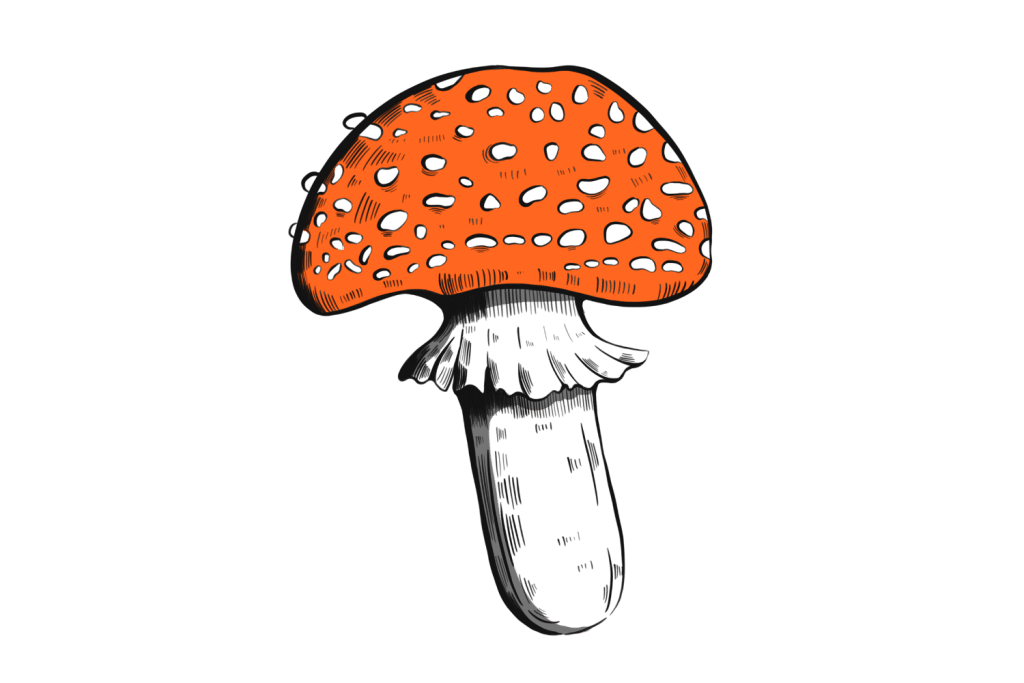
How to Prepare Fly Agaric
While I’ve said this before — I urge you against eating this mushroom at any doses higher than 1 gram (a microdose).
With that said, here’s how to prepare this mushroom for both food and as a psychedelic.
The process of preparing this mushroom involves exposing the mushrooms to conditions that promote as much of the toxic ibotenic acid to convert to muscimol as possible. This involves drying and gently heating the mushrooms with an acid such as vinegar or lemon juice.
Most people will then make the mushroom into a tincture by gently heating it with alcohol.
Here’s a method outlined by Psyched Substances from a video posted back in 2016:
What You’ll Need:
- Red wine (1 L)
- Dried Amanita muscaria (60 grams)
- Sliced apple (½ an apple)
- Nutmeg (a pinch)
- Apple cider vinegar (15 mL)
- Cinnamon sticks (3 sticks)
Step 1: Mix All The Ingredients Together & Cook On Low Heat
Add all the ingredients and bring them up to temperature. You don’t want it to boil, but you want to see some movement in the fluid as it heats up.
Leave it on low heat for about 3 hours, stirring frequently.
Step 2: Cool & Strain The Liquid
After 3 hours, turn off the heat and let the mixture cool.
Strain it with a strainer, tea filter, or cheesecloth and pour the liquid into a dark glass container.
Potency & Dose
This mixture will boil down by about 25% by the time it’s finished, but it’s important to measure the final volume when you’re done in case you get something different. The final volume of the fluid is going to affect the dose.
To find the potency of this concoction, divide the amount of mushroom you started with (60 grams) by the final volume (in mL).
If you finished with 750 mL of liquid, the potency would be equivalent to 0.08 grams (80 mg) per mL of fluid. Psyched Substances took the equivalent dose of around 15-20 grams of dried mushrooms for his experiment (about 200 mL of the tincture).
Alternative Method: Sun Tea
A simpler (but less efficient) method is to make sun tea.
To do this, simply fill a jar with dried Amanita muscaria along with some water and a bit of vinegar or lemon juice. Seal it up and leave it in the sun for the day.
At the end of the day, it can be consumed.
Is Amanita Muscaria Legal?
Amanita mushrooms are not controlled substances in the United States, Canada, or the United Kingdom. The exception in the US is the state of Louisiana, which banned Amanita muscaria along with dozens of other psychoactive plants and fungi under Louisiana State Act 159.
This mushroom is illegal in Australia, and the active ingredient, muscimol, is listed as a Schedule 9 drug.
Amanita is also legal in Sweden and Ukraine — but banned in European countries such as Romania and The Netherlands.
Related: Comprehensive list of legal psychoactive substances.
Folklore & Traditional Use of Fly Agaric Mushrooms
There’s a lot of folklore surrounding the Amanita muscaria mushroom. This is due in part to its psychedelic nature, as well as its distinct and characteristic appearance. It’s hard to miss these mushrooms in the forest with their bright red and white caps.
There’s some mention of this mushroom being used by the early Vikings of Europe. It’s been suggested that Amanita muscaria was used by the Vikings to induce berserker rages during battle.
The famous ethnomycologist of the 1960s, R. Gordon Wasson, once suggested the fly agaric could be the infamous Soma mentioned in the Rigveda — one of the four sacred texts of Hinduism.
Soma was a ritualistic drink used to induce a state of intoxication. It isn’t clear what species was used or even that Soma refers specifically to one species at all. Some of the other suggestions include Psilocybe cubensis mushrooms, Peganum harmala, and Ephedra sinica.
John Marco Allegro, an archaeologist and Dead Sea Scrolls scholar, once suggested that early Christianity may have originated from a fertility cult involving the use of Amanita muscaria. Unsurprisingly, this controversial theory is hotly debated by members of the Christian community. One of the most outspoken critics of this theory was the late Henry Chadwick, the Dean of Christ Church, Oxford.

Amanita Muscaria & The Origins of Christmas
There are also theories that the traditions involved with Santa Claus and Christmas were derived from the amanita mushroom. Here’s the summary of the overlap of fly agaric and Christmas folklore:
1. Flying Reindeer
In Lapland, Siberia, and Finland, it was common for the shamans who used Amanita muscaria to travel with the help of a reindeer-drawn sled in the winter. The reindeer would often follow the shamans around until they urinated to eat the pee-covered snow. The urine of someone who recently consumed fly agaric is still highly psychoactive, and the reindeer appeared to seek out this experience.
One of the most common experiences reported from fly agaric mushrooms is the sensation that one is flying. Hence, the getaway vehicle Santa employs to travel the world on Christmas eve is essentially made up of tripping (flying) reindeer.
2. Santa Claus’ Red & White Outfit
Some reports suggest the shamans that used Amanita muscaria would often wear clothes inspired by the mushroom. Living in a very cold region of the world, they would wear thick layers of clothing dyed red and white to match the distinct color scheme of the fly agaric mushroom.
3. Santa Lives in the North Pole
Most of the history around the fly agaric came from northern regions of the world. It was used by the Vikings, Siberians, Finish, and Swedes — all of which are fairly close to the North Pole.
Fly Agaric in Pop Culture
Fly agaric mushrooms are pervasive in pop culture. It’s often referred to as the “Mario mushroom” for its presence in the Mario Bros. games. When the mushroom is eaten, Mario grows in size — which is an ode to a common sensation produced by this mushroom that alters the perception of the size of objects.
This mushroom also has a similar role in the story of Alice in Wonderland. Alice is told by the hookah-smoking caterpillar that if she eats one side of the mushroom, she’ll grow larger, but if she eats the other, she’ll grow smaller.
The fly agaric is also the only mushroom with its own emoji ?. It’s become the universal symbol for psychedelics.
There have been a few books revolving around the experience induced by this mushroom. They’re usually quite bizarre like Alice in Wonderland or Fantasia. A good example of this is the book by Andrija Puharich titled “The Sacred Mushroom: Key to the Door of Eternity” (a very strange book).
Related: Best Books About Psychedelics

How Amanita Muscaria Works
Amanita muscaria is completely distinct from all other psychedelics. It doesn’t target the 5-HT2A receptors like most classical psychedelics, and it doesn’t work through the kappa-opioid receptors like unconventional psychedelics like salvia, ketamine, or DXM (dextromethorphan).
The class with the most similarities is the tropane alkaloids (think, datura, mandrake, or the borrachero tree). The similarity is that both the tropane alkaloids and the active ingredients in fly agaric both target the cholinergic system — but in completely opposite ways.
Ibotenic acid and muscimol are classified as cholinergics — which means they stimulate or activate the acetylcholine receptors.
Acetylcholine is the chief regulator of the parasympathetic nervous system. By activating this system, fly agaric effectively increases parasympathetic activity. This is what leads to side effects like sedation, increased salivation, and increased urination.
It’s unclear exactly how this system can lead to such profound psychoactive effects — a phenomenon experienced when this system is both blocked and stimulated.
The active ingredients also interact with other neurotransmitters that may contribute to their psychoactive effects as well.
Ibotenic acid has a similar structure to a neurotransmitter called glutamic acid — which is the primary neurostimulating compound in the central nervous system. This allows it to bind and activate the NMDA glutamate receptors [3]. This is thought to play a role in the psychoactive effects of this mushroom.
The other active ingredient, muscimol, has a structure similar to another neurotransmitter known as GABA — which is the primary neuro-inhibitory compound in the central nervous system.
It’s thought that the combination of the glutamatergic and GABAergic effects of these compounds contributes to the psychoactive effects of this mushroom [4].
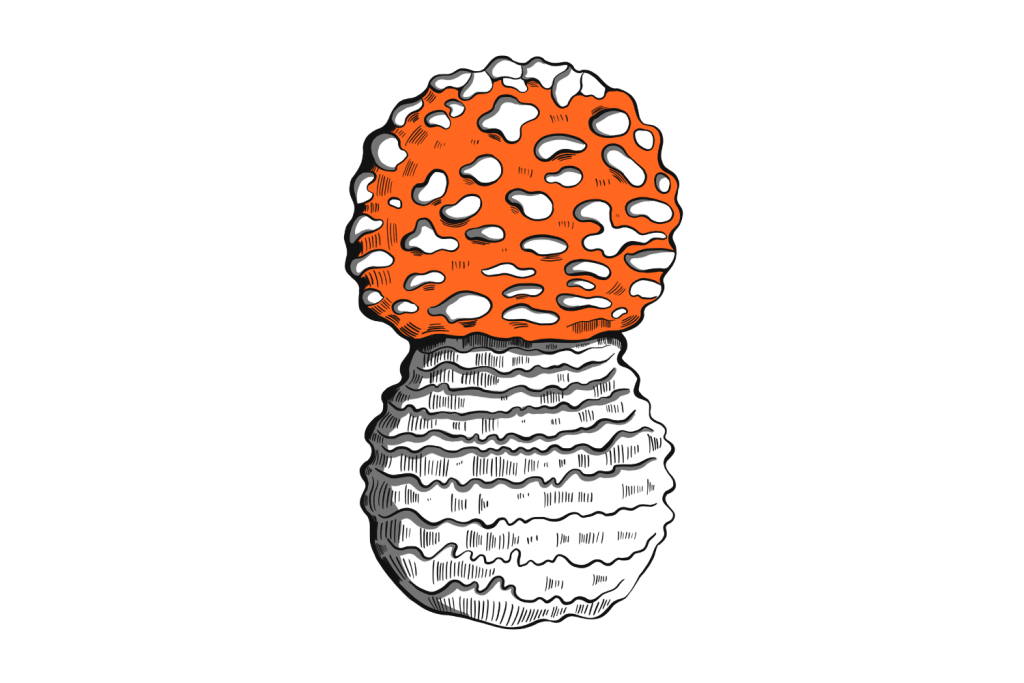
Frequently Asked Questions About Amanita Muscaria
Nothing about this mushroom is conventional. Everything from its bright red and white appearance, its elusion from cultivation, and its strange dreamlike visions are unlike any other natural substance.
Unsurprisingly, many of our readers have reached out with further questions about this substance. Here are some of the more common questions we get asked.
1. Can Amanita Mushrooms Be Cultivated?
No. So far, all attempts to cultivate this mushroom have been unsuccessful.
This mushroom has a complex symbiotic relationship with its host trees — which are most commonly poplar or pine. The mushroom needs these trees to survive. Even after inoculating trees with the fungus, reproducing it is often unsuccessful. Some people have reported success, but they’re given one or two mushrooms every couple of years — far from a reliable yield.
It’s thought there are other plants or soil microorganisms found in forests that this mushroom needs to survive and thrive.
2. Where Does the Name “Fly Agaric” Come From?
This mushroom used to be employed for killing flies. The mushroom would be harvested and mixed with milk to attract the flies. Flies feeding on the mushroom would become intoxicated and die.
3. Will Amanita Muscaria Make Me Dream?
Yes. The effects of Amanita muscaria have a much stronger impact on the experience of dreaming than it does on waking consciousness. Even very low doses of this mushroom are strong enough to impact dreaming.
People who take this mushroom often report outlandish, sometimes lucid, and sometimes terrifying dreams. They feel real when they’re happening but are hard to interpret or remember once the dream is over.
4. Is Amanita Muscaria a Magic Mushroom?
This mushroom has no affiliation with proper magic mushrooms. It’s a completely separate species with entirely different active ingredients.
Most magic mushrooms come from the genus Psilocybe, but there are other species as well. All magic mushrooms contain a combination of psilocybin and psilocin. These compounds work through the same mechanism as other psychedelics like LSD, DMT, or mescaline by targeting the 5-HT2A receptors.
The fly agaric mushroom is nothing like any of the other classical psychedelics. It works through the cholinergic, glutaminergic, and GABAergic systems instead.
This effect isn’t found in any other psychedelic, even unconventional substances like ketamine or salvinorin A (the active ingredient in salvia) — both of which work through the kappa-opioid receptors.
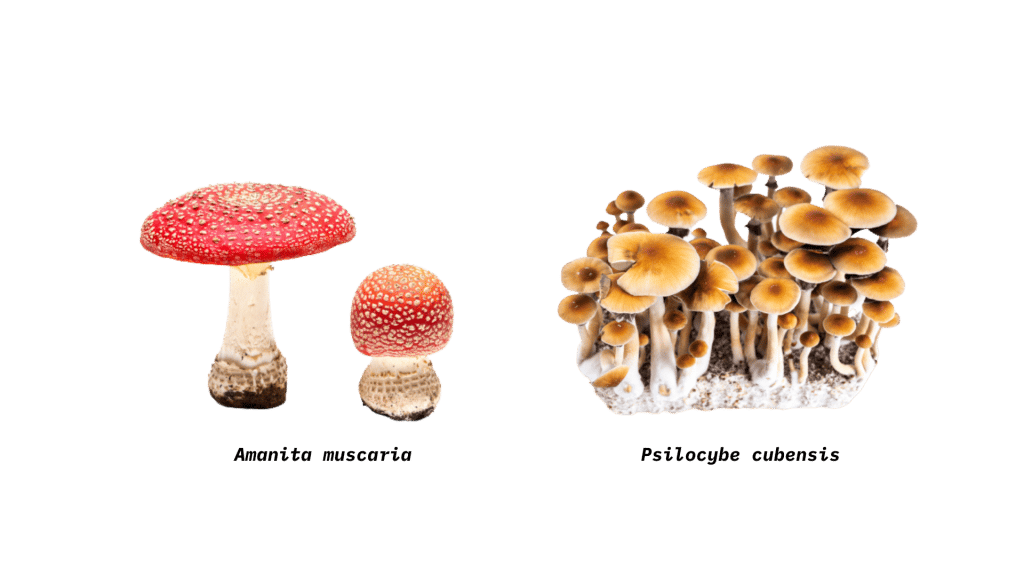
Final Thoughts: What is Amanita Muscaria?
This mushroom is one of the strangest psychedelics on Earth. It isn’t particularly medicinal or visionary like other psychedelics, and it doesn’t follow any of the conventional pathways for producing its psychoactive effects.
Even the psychedelic profile of this fungus is hard to describe. It doesn’t warp or change the appearance of objects in the way that LSD or psilocybin do — but it does make objects appear strange or abnormal. It makes everything appear like a dream. Its sedative nature can even lead you to fall asleep — at which point the hallucinations intensify exponentially.
The best way to use this mushroom is in small doses as an oneirogen for achieving more intense and vibrant dreams.
Remember: This mushroom does have some toxic effects, especially at higher doses. While it’s unlikely to cause serious physical harm, side effects can be extremely uncomfortable.
References
- Theobald, W., Büch, O., Kunz, H. A., Krupp, P., Stenger, E. G., & Heimann, H. (1968). Pharmacological and experimental psychological studies with 2 components of fly agaric (Amanita muscaria). Arzneimittel-forschung, 18(3), 311-315.
- Garner, C. D., Armstrong, E. M., Berry, R. E., Beddoes, R. L., Collison, D., Cooney, J. J. A., … & Helliwell, M. (2000). Investigations of amavadin. Journal of Inorganic Biochemistry, 80(1-2), 17-20.
- Jørgensen, C. G., Bräuner-Osborne, H., Nielsen, B., Kehler, J., Clausen, R. P., Krogsgaard-Larsen, P., & Madsen, U. (2007). Novel 5-substituted 1-pyrazolol analogues of ibotenic acid: synthesis and pharmacology at glutamate receptors. Bioorganic & medicinal chemistry, 15(10), 3524-3538.
- Michelot, D., & Melendez-Howell, L. M. (2003). Amanita muscaria: chemistry, biology, toxicology, and ethnomycology. Mycological research, 107(2), 131-146.

